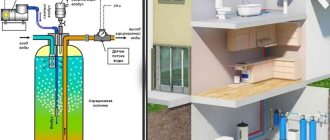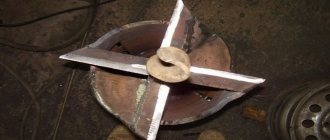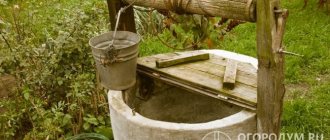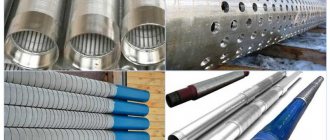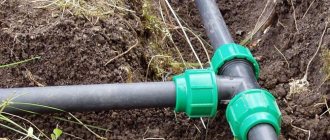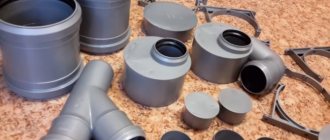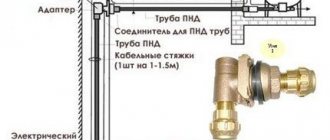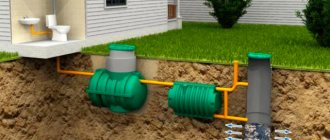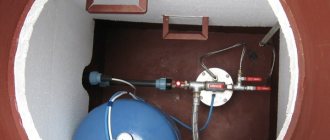For individual water supply to country private houses and cottages that do not have access to the central water supply main, the main source of water is underground pools, which are easier and cheaper to access using a well. Typically, specialized companies are engaged in drilling deep-water wells with high flow rates (fillability), but you can significantly reduce financial costs by further equipping the water well yourself.
The task is not so simple due to the many factors influencing decision-making on the well construction method; you will mainly have to take into account your financial capabilities, the casing material, the characteristics of the well source and pumping equipment, and the climate in the region where you live. When installing (piping) a well yourself, you should select in advance the type of electric water pump (surface or submersible), draw up a plan for connecting it to auxiliary devices and determine its location.
Station in a caisson
Main specifics
The list of equipment for a water well that will be required for installation is well known to drilling specialists. But if you decide to carry out the work on your own, then you need to know the basics of well construction. In short, the main work will be drilling a mine and installing the necessary equipment.
A water well must be equipped with:
- Caisson;
- Pumping station;
- Power source (electric motor);
- Well head.
Layout diagram relative to the house and water layers
Installation of the necessary equipment
Arrangement activities provide:
- Supply of clean water;
- Protection from negative environmental influences (frost, rain erosion, etc.);
- Ability to properly maintain all devices.
Places for installing all equipment must be provided in advance, at the very beginning of work. Installation can be done both inside the house and directly near the well. The installation option at the well says that it will be necessary to build a special room to accommodate all the necessary devices.
The construction of an additional building is more convenient from the point of view of convenient placement of all elements of the pumping unit necessary for the operation of the well. You can also place water outlet and electrical equipment there.
Auxiliary devices:
- Water filtration system;
- Pressure control system;
- Pressure control system;
- Automatic control system.
If the well is located near the house, this will save on drilling work, as well as on the purchase of pipes. This arrangement also reduces the power consumption of the pump for transporting water.
All drilling work also has its own nuances. The equipment used depends on many factors, such as the composition of the soil, the location of the well on the site, and the water supply scheme.
Machine drill
Water supply diagram from a well
The required water supply option must be asked at the very beginning of the project. The set of necessary equipment, as well as the composition and quality of the supplied water, will depend on the specific scheme. There are various water supply options.
The simplest type for a summer residence is the Abyssinian well, with a water depth of up to 15 meters. Water in such a well can be supplied through a narrow pipe.
Feeding system
The intermediate type, these are wells with up to 50 meters of rising water, is well suited for private households. Their main disadvantage is their short service life due to poor thermal insulation.
And the most difficult, both from the point of view of work and from the point of view of arrangement, is the option of an artesian well, with a depth of 50 to 200 meters. It is well protected from frost and other influences. But drilling such a well is not cheap, and there is also the problem of self-flowing of such wells, that is, the water goes up without a pump. This imposes certain conditions on the arrangement. There are two ways:
- Install the caisson;
- Equip the head with a tap from which water will constantly flow.
Caisson scheme
Scheme with a tap
Installing a caisson is attractive because it establishes a closed water supply cycle. The source is reliably protected by the reservoir from dirt and weather conditions. For private households, you can use cylindrical tanks with a diameter of up to 100 cm and a height of up to two meters. The positive aspects of modern caissons are:
- Saving free space in the house;
- Lack of global thermal insulation work;
- Corrosion protection;
- Plastic molded housing.
General form
Installing a caisson
The option with a tap is often used for irrigation. To protect the well from freezing, it is necessary to divert the self-flowing flow along the slope away from the well. The water from such a spring will not freeze at the outlet, since its temperature is +3 - +5 degrees. It is impossible to shut off water in such a well; this will lead to the head being destroyed and water pouring into the area. When arranging this type of arrangement, you need to take a competent approach to planning and become well acquainted with the theory.
Outflow of water
Types of underground water sources
Groundwater is located in finely dispersed soils, voids, pores and cracks in rocks, which are called aquifers (water-bearing).
Some aquifers allow water to pass through, while others retain it and are impermeable. In the first case, we are talking about loams (soils with a high sand content and a small amount of clay) and hard sandy loam, in which water volumes are located in lenses or cracks.
Waterproof deposits include clay deposits and rocky (semi-rocky) rocks in an intact state without cracks. If the rock is cut with various cracks and filled with water, then it is called water-containing.
Groundwater can flow within its reservoir under the influence of gravity along a slope to the lower layers. Water basins that do not have access to the lower layers or side branches, when increasing in volume, begin to gush out from high pressure - as a result, geysers and springs appear on the surface.
Depending on the nature of the soil in which underground water basins are located, the following types of water are distinguished according to their physical properties:
Sedimentary deposits. Water layers are placed in sand with different size fractions, in the free space between gravel, pebbles, and crushed stone. Since the fractions of these soils are in a mobile state and are not connected to each other, water can pass through them in any direction with the least resistance. Also, finely dispersed soils have high filtration qualities.
Pools in sedimentary rocks are recharged with water due to precipitation and its infiltration through the above layers of soil. It is also possible for them to be saturated along the horizon from located reservoirs or overlying slopes.
Rice. 2 Types of groundwater
Indigenous breeds. Water pools can be located in lenses and cracks of rocky, semi-rocky and sedimentary soils cemented under high pressure. These cavities are constantly replenished with water resources when the pressure drops that occurs as a result of water intake. The most famous rock from which water intake is made is limestone.
Bedrock has a rigid and durable crystalline structure that prevents water from flowing out of its space. Due to the great depth, high pressure is exerted on the water basins. As a result, when the rock is exposed during drilling, the water level rises much higher than its depth, and in some cases the source gushes out when the water basin is between two hills.
Based on their hydraulic properties, underground water basins are divided into the following categories:
- Non-pressure. These are water sources located in sedimentary rocks at shallow depths. They are fed by precipitation and discharged into reservoirs or underlying layers, so the pressure of the water layer is close to zero.
- Pressure. These are deep-lying basins where pressure is exerted on the water layers by a massive layer of soil of great thickness. These include deep wells in sand in sedimentary rocks and artesian springs.
Sometimes the pressure in a well drilled in sedimentary rocks is higher than normal. This is due to the fact that the water-sand pool is bounded above and below by layers of clay that do not allow liquid to pass through. Such waters are called interstratal or low-pressure waters.
Rice. 3 The principle of accumulation of groundwater in sedimentary rocks
Related article:
How to find water on a site for a well - folk and scientific methods . It may be interesting to read an extended article about the options for drilling a well or digging a well on your own and with the involvement of water specialists.
Significant Features
Before starting any work, you need to conduct a reconnaissance of the groundwater level in your area. The position of the main protective structure of the well (on the surface or underground) will depend on its level. To protect the fertile layer of the earth, it is necessary to use cluster drilling. This option reduces the level of dumping work during drilling.
A very important part is the choice of pump and its installation. The pumping station plays the most important role in the well system. A rational choice would be to use a submersible pump, since its performance indicators are among the best, plus it is well suited for this type of water supply system. The choice depends on many factors, the main of which is depth, for example, with a well depth of 33 meters, it is necessary to maintain a pressure of 1.4 to 3 atmospheres.
Location options
Equipment option
Before installing the pumping station, it is necessary to pump the well and clean it of dirty water. The pump, with its hermetically sealed power cable, must be completely immersed in water, but not touch the bottom of the well.
Operating pressure is maintained and adjusted using a hydraulic accumulator. The spacious storage capacity allows you to control the pressure in the system. There are varieties of different volumes for different categories of systems.
Water supply plan
Hydraulic accumulators
The main protective element of the deep part of the well is the head. It is equipped with fastenings for installing water pipes and other equipment.
Head design elements:
- carabiner for securing the pump;
- flange for attaching the head to the shaft;
- O-rings;
- mounting bolts;
- upper and lower head caps.
Complete view
Design
After installing the head, the column is cut off. It must be cleaned and treated with an anti-corrosion compound.
General view of the well system
What is harness and its general requirements
Piping is the arrangement of a well where it is planned to install an automation unit to pre-laid pipes. That is why there are general requirements that must be followed. For example, when piping a well, you need to decide for yourself when you will use it.
If you plan to use it only during the summer period of operation, then there is no need to bury the pipes. In the case of the winter version, the pipes must be deepened to the extent of soil freezing, which for the central part of Russia corresponds to the required depth of 1.6 m.
You can bury a little more than a meter, but then the pipes will need to be insulated.
A pit should be built. Its depth must be at least 2 m in case the automation unit is installed on the street.
Experts recommend installing automation in the boiler room of a private house or cottage, since there is less dampness here, which means the pressure switch and other components will last longer. In a warm and dry room it will be easier to maintain them in case of repairs.
It is necessary to configure the pressure switch. Here you need to set the minimum and maximum threshold for relay operation. When the minimum threshold is reached, the relay closes the contacts, the pump turns on and pumps water into the accumulator.
When the maximum threshold is reached, the pressure switch opens the contact and the pump turns off. The minimum pressure threshold is set at one and a half atmospheres, the maximum - about 3-4 atmospheres. All this is purely individual and depends on the sources of water consumption in the house.
It is necessary to select a hydraulic accumulator. Here the emphasis is on capacity. Remember that only half of the accumulator capacity is filled with water. That is, if you take a 100-liter hydraulic accumulator, then only 50 liters of water will be there, the rest of the space is filled with compressed air.
How to choose the right accumulator volume for a well:
Selection and installation of equipment for water supply
Water supply equipment differs in type and installation location. The main elements are:
- a pump that is lowered into the well or placed on the surface;
- automation that ensures turning the pump on and off, protection against overloads;
- hydraulic accumulator - a container for storing water.
The hydraulic accumulator is of open and closed type. The open one is installed at the highest point of the building. A closed (membrane) hydraulic accumulator that maintains constant pressure in the water supply is preferable.
Surface pump for shallow well
Surface equipment is easy to install and is cheaper than submersible equipment. The scope of application is limited by the depth of the water level. If it exceeds 8 m, it is difficult for the pump to capture water. The maximum depth is 10 m , but in this case the equipment operates with minimal productivity and takes a long time to start up.
The most rational solution is to install a pumping station, equipped, in addition to the pump, with a membrane tank and automation. Buying a three-in-one set is cheaper than purchasing individual components.
Surface pump.
The station is placed on the surface, the hose from it is lowered into the well. This simplifies installation and maintenance. The water intake pipe is small in diameter, which allows the station to be used in an Abyssinian well.
Submersible pump for deep well
From a depth of more than 10 m, water can only be raised with a submersible pump. Some products are equipped with automatic control, protection against voltage surges, and dry running.
Mandatory elements of water supply equipment for a private home are a hydraulic storage tank and automation. The deep pump ensures that water rises to a great height, so there are no restrictions on the choice of location for the membrane accumulator. It and the automation can be placed at a great distance from the source of water intake - this has little effect on productivity. An excellent choice of location would be a utility room, where it is dry and clean.
The deep pump is mounted by lowering it into the well to a level below the water level along with other devices:
- cable for supplying power to the electric motor;
- plastic pipe;
- stainless steel safety rope.
Fastening is carried out to the well head.
Connecting a hydraulic accumulator, automation
To fully equip a water well, it is necessary to install a pump, equipment and automation, which include a hydraulic accumulator, relay and pressure gauge, in the prepared caisson pit. If you use a station, all the components necessary for water intake are collected in one module, all that remains is to connect its input to the pressure pipe through a compression fitting and in a similar way connect it to the water supply supply to the residential building.
When connecting a pumping station, the help of a specialist and the use of special tools are optional - the HDPE pipeline is connected with straight or angled threaded compression fittings manually, or using a wrench on metal parts.
Well protection from atmospheric influences
An open source of water intake is exposed to frost, rain and melt water, which threatens operational failures and breakdowns. To protect the installation, various design options are used.
Option 1: above-ground pavilion house
Above ground pavilion house.
The structure in the form of a pavilion house can be seen next to private houses, more often at industrial water wells. Its main purpose is to protect against exposure to weather conditions. It is advisable to build the room from brick, concrete, logs. In addition, sandwich panels and foam blocks are used. Insulation is carried out with heat insulators; it is additionally advisable to deepen the building to reduce heat loss. How far the structure should be lowered into the ground depends on climatic conditions; in some regions, the construction of such a protective structure is impractical.
Option 2: placing the source inside the building
The building is erected over a water source after drilling a well. You can use a basement, utility room, greenhouse, garage as a place for arrangement.
The advantages of this method are that the equipment is protected from cold and moisture and protected from thieves. Installing and servicing devices inside the building is simple and convenient. There is no interference for residents: the sound of a running pump cannot be heard through a closed door.
Option 3: underground caisson well
Various materials are used to make protective structures:
- Plastic. This caisson is a round or rectangular structure, which is characterized by durability, tightness and good thermal insulation. The product is convenient for installation due to its light weight, but this quality creates difficulties with high groundwater levels. To prevent the container from floating, it is fixed on a pre-constructed concrete base.
- Metal. Metal caissons are often made by hand from steel 4 mm thick. The sheets are welded, then treated on all sides with an anti-corrosion agent and painted.
- Reinforced concrete rings. Their installation is fraught with difficulties due to their heavy weight. Strong pressure on the soil leads to distortions and subsidence of the structure. The advantage is durability.
- Brick. Brick structures require reliable waterproofing. Only well-burnt red brick will do.
Underground well-caisson.
Caissons of all types are mounted in the same way. Instructions for installing plastic structures:
- They dig a pit, the dimensions of which are 30 cm larger than the protective device on all sides. The depth of the pit should be such that the neck rises above the ground by at least 10 cm. If there is a threat of the structure being pushed out by groundwater, the bottom is concreted.
- A caisson is prepared, in the lower part of which a hole is cut for the well casing pipe, and in the side part - for the water supply pipe. If it is planned to place a hydraulic accumulator in the tank, the hole in the bottom is shifted to the side so that there is enough space and it is convenient to service the equipment.
- Lower the structure to the bottom, stringing it onto a pipe. The casing pipe is cut, the main pipe is installed, and the joints are sealed.
The work is completed by backfilling the soil around the tank walls and installing the necessary equipment. The neck is insulated.
Caisson device
When using a well source for water intake only in the summer, an external shed or pit with dimensions suitable for placing a pump and equipment, providing free access for maintenance and control, is built on a dacha plot for protection from precipitation. The walls of a dug pit of small depth are usually lined with brickwork, crushed stone is poured onto the bottom or a screed is made, and the structure is covered with an airtight lid on top.
With a constant individual water supply to the house, the summer equipment is replaced with a capital engineering structure - a caisson well, which, in addition to protecting the equipment from precipitation, provides its safety and thermal insulation during the cold season. Let's consider the main options for constructing caisson wells.
Concrete rings
Construction of a water well, where low price is the determining factor, is carried out using concrete rings. A caisson well is easy to assemble from standard factory parts: a bottom, two well rings with locks with a standard internal diameter of 1 m and a height of 0.9 m, a cover with a hatch, the average cost of the entire set will be about 5,000 rubles.
Tip: Purchasing concrete rings with a finished bottom and lid will further simplify installation and improve its quality.
Types and sizes of products for concrete wells
To install a well, you will need a building level, a mixture of sand and cement in a ratio of 4:1; before installation, all concrete parts are coated on the outside with bitumen waterproofing (mastic) and dried well. The well is installed in the following order:
- Dig a hole of the required dimensions in depth and width, pour sand onto the bottom and level it horizontally.
- They make a hole in the bottom for the column; to do this, draw a circle of the required diameter and drill through holes around its perimeter with a hammer drill, then knock out the middle.
- Lower the bottom onto the cut casing (30 - 50 cm from the ground), nail it with a massive rubber hammer for horizontal installation.
- A small layer of cement mortar is laid around the perimeter, the first ring is placed on top, a layer of mortar is applied to its upper edge and the second ring is lowered.
Installation of a well made of concrete rings - A cover with a manhole is lowered onto the cement mortar, to which a plastic hatch is then screwed onto anchor bolts. Using a crown, drill the necessary holes in the walls of the well and bring the pipes out.
- Coat the junction of the bottom with the casing, the cracks near the exited pipes with cement-sand mortar, and additionally remove all joints and remove excess mortar.
- For hydraulic insulation, buy a dry mixture in bags, dilute it with water and coat all joints from the inside using a spatula or brush. It would not be a mistake to carry out a similar procedure for waterproofing the inner surface of the entire concrete chamber to prevent it from becoming saturated with moisture.
- After installing the rings, insulation is carried out - their surface is covered from the outside with sheets or narrow strips of foam plastic with further fixation, then sprinkled with earth.
Note: It is difficult to insulate a round-shaped well with straight sheets of polystyrene foam; for these purposes, you can purchase a foam plastic shell from some manufacturers, which is made of several segments and assembled on the surface of the rings by inserting fragments into each other.
Metal and plastic caissons - design
Metal
Caissons made of sheet steel 3-6 mm thick are manufactured by many enterprises and commercial firms; the welded structure of the working chamber has a round or square shape, with a square or cylindrical manhole welded on top. Due to problems with corrosion, steel is always covered with waterproofing on the outside; installation of a steel caisson is carried out according to the following scheme:
- A pit is dug for a caisson and a trench for laying HDPE water pipes, the bottom of the hole is filled with a screed 10 - 15 cm along the horizon.
- Holes for pipes are cut in the bottom and walls of the metal caisson, fittings are inserted to connect the internal and external pipelines, and the caisson is lowered onto a pre-cut casing.
- The bottom of the caisson is welded to the metal casing; if the pipe is made of plastic, a rubber cuff designed for its outer diameter is used for sealing.
- Insulate the side and top walls of the caisson from the outside with foam sheets (if it is square, this is quite easy to do) and sprinkle it with earth.
The standard height of a metal caisson is about 2 meters, the width is 1 m or more, the price depends on the size, thickness of the steel sheet and the manufacturer, the minimum cost of a standard design is 20,000 rubles, the average price of a quality product is 30,000 rubles.
Strapping scheme with a metal caisson
Plastic
Chambers made of concrete and sheet steel have high thermal conductivity, so in cold weather they have to be additionally insulated, which is not always effective and leads to additional financial costs. The best winter option is plastic caissons, which are currently gradually ousting cold-weather competitors from the market; their main drawback is their high price of about 40,000 rubles. for standard quality products. Almost all plastic caissons have a cylindrical working chamber and manhole with a height of about 2 m and a different internal diameter; they are installed in the following order:
- Dig a hole in such a way that there is a gap of 20 cm between its walls and the caisson shell, level the bottom with a cement-sand screed 15 cm thick. If the area is swampy and the bottom of the hole is flooded with groundwater, lay a concrete slab with a pre-cut hole for the pipe.
- Make the necessary holes in the caisson and place it on the top of the column using a transition rubber coupling.
- Cement-sand mortar is diluted in a ratio of 1:5 and poured along the edges of the pit, filling the space between its walls and the caisson shell; 10-15 cm of mortar is not poured on top, leaving room for soil for landscaping the area.
Installation diagram of a plastic caisson
Dimensions of the well protection structure
The dimensions of the protective structure must be such that the installer can easily carry out his work.
Dimensions depend on the installation location of the equipment. If it is not located above the wellhead, 0.8 x 0.8 m is enough for a person to lower the pump. If a pressure accumulator or station is supposed to be installed in the caisson, add at least 0.5 m in front and behind.
If reinforced concrete rings are used to construct a protective structure, the minimum acceptable size is 90 cm, provided that the equipment will be located in the house. Inside the ring with a diameter of 150 cm, medium-sized equipment is placed, leaving space for the installer to work. A circle with a diameter of 200 cm allows you to place a tank with a volume of 200 liters inside.
What is used to supply water to the house
For this, it is best to use galvanized metal pipes - reliable and durable. Polypropylene or polyethylene pipes are used as a budget option, but they are not as reliable.
You also need an expansion tank, automation and filters. The tank is made in the form of a sealed vessel, which can be of different volumes and pressures. It is also possible to provide automatic protection against dry running. It will turn off the pump if the consumption is too high and the water does not have time to flow from the depths.
In addition, based on water tests, a water treatment system and filter are selected. It must be set if, according to the results of the analyses, the water parameters are higher than the maximum permissible concentrations.
Ensuring the tightness of the casing pipe
The casing pipe must be protected from the penetration of dust and melt water, which are sources of microorganisms. For sealing, a special device is used - a head made of cast iron or plastic, capable of withstanding a load of 200 kg. The device consists of:
- flange;
- covers;
- carbine;
- cuff;
- fasteners.
The head is selected according to the diameter of the casing pipe and, after being mounted on it, is fixed with a flange. The entrance cover has holes for entering the power cable and water pipe. All connections to pipes and cables are reliably sealed with rubber seals. A gasket is installed under the cover before fixing it with bolts.
Using a Downhole Adapter
An alternative to an expensive caisson or house is a well adapter. The design allows you to bring the water pipe into the house directly from the well. The device has the form of a collapsible fitting and consists of external and internal parts. The water main is connected to the outer one, and the hose from the pump is connected to the inner one. Both parts are fixed to the wellbore, repeating its shape. Tightness is ensured by double sealing.
Using a downhole adapter.
When choosing an adapter, you should consider the following:
- The structure is located below the soil freezing level, and in the event of a breakdown, excavation work will be required.
- The casing pipe comes to the surface and is closed with a lid. An electrical cable is inserted through it.
- In winter, the well may freeze through the casing, so it is wrapped in heat-insulating material.
- Installation of equipment is possible only in the house.
- Installation of the adapter requires a special key.
Tips for constructing a well
At a dacha where people do not live in winter, it is recommended to place the equipment in a caisson, where the temperature is always above zero. Before leaving, they drain the water , even if they are away for several days in winter. In residential homes, the best place for equipment is in the apartment building. It is dry and warm, convenient maintenance.
Other useful tips:
- In areas with high groundwater levels, it is better to use ground protection structures or an adapter.
- To avoid damaging the water supply to the house, use a protective casing. This is especially important in quicksand, heaving and rocky soils. The electrical cable is always placed in a pipe.
- The water supply circuit must include a check valve for the pump and a filter for the accumulator tank.
- Shut-off valves are used to connect hydraulic equipment. This makes repairs and maintenance easier.
- It is necessary to constantly monitor the pressure in the accumulator and, if necessary, pump it up.
Briefly about the main thing
Modern arrangement of a well in a country house or area with a cottage is carried out to protect the water source, equipment, and pipeline system from dirt, precipitation, dust, the negative effects of low temperatures, melt and rain water. To do this, the installation or construction of a protective structure is carried out. It can be above ground level or in the ground. One of the options is also to arrange a special technical room in the house. Regardless of the option, it is used for installing a pump, accumulator and automation.
Ratings 0

